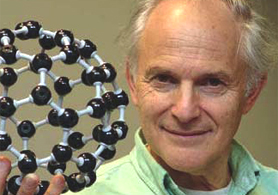The New Zealand Herald’s Chris Barton interviews Sir Harold Kroto, a Nobel Prize winner and pioneer in the field of Nanoscience.
An excerpt:

“Carbon 60, aka Buckminsterfullerene, is his claim to fame. Its discovery in 1985 by Kroto, Robert Curl and Richard Smalley led to the trio getting the Nobel Prize in Chemistry in 1996. It also ushered in a new era of “caged compounds” and signalled the birth of nanoscience – the science of the extremely tiny, of things on an unimaginably small scale.
Or, as physicist Richard Feynman put it in 1959, “a staggeringly small world that is below”.
While the word “nano” originally meant “dwarf” and has been used to describe small things – such as “Nanosaurus” for a dinosaur only a metre long, or, more popularly, the iPod “nano” Apple’s smallest media player – neither comes close to just how small things are on nanoscale. Nano refers to a nanometre (nm) – a millionth of a millimetre. It is the measure of atoms – a world so minuscule it can only be seen with complex electron and scanning tunnelling microscopes.”
Kim Hill also interviewed Harry Kroto on her Saturday morning Radio New Zealand show. You can listen to the audio here.